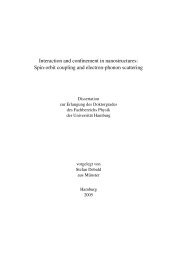Measuring the Electron Beam Energy in a Magnetic Bunch ... - DESY
Measuring the Electron Beam Energy in a Magnetic Bunch ... - DESY
Measuring the Electron Beam Energy in a Magnetic Bunch ... - DESY
Create successful ePaper yourself
Turn your PDF publications into a flip-book with our unique Google optimized e-Paper software.
measurement is limited by <strong>the</strong> <strong>in</strong>jector phase jitter. This means that 0.07 is a ra<strong>the</strong>r<br />
pessimistic value for <strong>the</strong> phase jitter of <strong>the</strong> first accelerator section, s<strong>in</strong>ce it represents<br />
more <strong>the</strong> jitter between <strong>the</strong> phase of <strong>the</strong> gun laser and gun RF. The true value of <strong>the</strong> first<br />
accelerator section jitter could be anywhere between 0.01 and 0.07, but based on<br />
pr<strong>in</strong>ciples of <strong>the</strong> regulation algorithm, <strong>the</strong> amplitude jitter should always be ~1.8 times<br />
<strong>the</strong> phase jitter [19], so for future calculations, we will assume a phase jitter of 1e-4 or<br />
0.02 degrees.<br />
These numbers are also only applicable for short bunch tra<strong>in</strong>s and 1 nC bunch<br />
charge. When long bunch tra<strong>in</strong>s with 3 nC were used <strong>in</strong> <strong>the</strong> 9 mA experiment for ILC<br />
research, due to <strong>the</strong> large beam load<strong>in</strong>g effect, <strong>the</strong> energy jitter of <strong>the</strong> bunches at <strong>the</strong> end<br />
of <strong>the</strong> bunch tra<strong>in</strong> was ten times worse than <strong>the</strong> energy jitter of <strong>the</strong> bunches at <strong>the</strong><br />
beg<strong>in</strong>n<strong>in</strong>g of <strong>the</strong> bunch tra<strong>in</strong> [24].<br />
While <strong>the</strong> comb<strong>in</strong>ation of a new down-conversion front-end [22], reference<br />
<strong>in</strong>jection [21] and system identification [11] could conceivably stabilize <strong>the</strong> cavity<br />
amplitude jitter and drift to with<strong>in</strong> 1e-5 for short bunch tra<strong>in</strong>s <strong>in</strong> a well tuned mach<strong>in</strong>e, it<br />
is unclear what <strong>the</strong> system performance would be under more typical circumstances.<br />
Us<strong>in</strong>g <strong>the</strong> present mach<strong>in</strong>e as an example, <strong>the</strong> best results are different from <strong>the</strong> typical<br />
results for short bunch tra<strong>in</strong>s by about a factor of 2. For long bunch tra<strong>in</strong>s <strong>the</strong> difference<br />
can be a factor of 10-30<br />
A beam-based feedback system is be<strong>in</strong>g developed to complement this cavitybased<br />
system because beam-based measurements can often provide a more accurate<br />
measure of how much energy <strong>the</strong> beam ga<strong>in</strong>ed <strong>in</strong> <strong>the</strong> cavity than a measurement of how<br />
much energy <strong>the</strong> cavity lost when <strong>the</strong> beam traversed it. The reason for this is that <strong>the</strong><br />
beam-based measurement can often be accomplished <strong>in</strong> one location, with one pickup<br />
and one set of electronics, while <strong>the</strong> cavity measurement requires a sum of signals from<br />
many different pickups <strong>in</strong> an RF vector sum. The beam-based measurements can also be<br />
drift-free relative to an optical reference which is used to synchronize various laser<br />
systems through optical cross-correlation. It is not possible to use an RF reference to<br />
synchronize <strong>the</strong> beam to lasers with femtosecond precision.<br />
The beam position monitor developed <strong>in</strong> this <strong>the</strong>sis is ideally suited for use <strong>in</strong> a<br />
beam-based feedback system because it provides beam energy measurements with

















